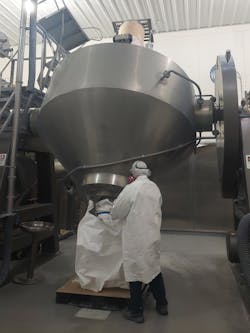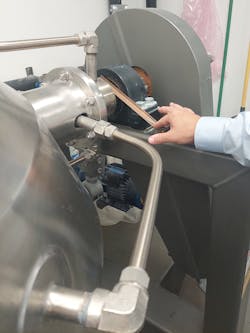Controlling static electricity during bulk solids mixing

Static electricity, also known as "triboelectricity," is created when two materials rub together.1 This friction generates a static charge, which can have costly and even dangerous consequences in today's technology-driven world. Uncontrolled static electricity can lead to electrostatic discharge (ESD) and various associated problems, including fire hazards and difficulties with powder discharge or flow during bulk solids processing. Additionally, static electricity can attract unwelcome impurities, leading to flaws or failures in the product. This problem is frequently seen in bulk solids blenders, mills, and screeners.
Processors can safeguard their expensive equipment and increase production by taking proactive measures to reduce and control static electricity. This article will explore the importance of static charge dissipation in blenders and offer practical solutions to prevent and mitigate static electricity issues.
Navigating static electricity
Static charges can create unsafe working conditions, cause segregation of materials during discharge, result in slow or inefficient mixing, and leave excessive powder residue on blender walls. Manufacturers frequently try to cut costs by switching to synthetic materials, but due to their poor conductivity, these materials are more likely to hold charges. Glass, Lexan, nylon, lead, aluminum, and paper are examples of positively charged materials, while hard rubber, polyester, and silicon are examples of negatively charged materials.
Safety. The top priority when it comes to static electricity is safety. Static electricity can create a shock hazard for workers, especially in areas with high humidity or low conductivity. This highlights the importance of controlling static electricity to ensure a safe working environment, by eliminating potential hazards, providing advanced engineering, and using personal protective equipment. Processing equipment must be grounded, because if it is isolated, there is a chance that electrostatic discharge will occur over time and potentially cause a dust explosion.
Segregation. Static charges in bulk solid materials can cause segregation during discharge, which can result in uneven mixing and poor product quality. Consider the plastics sector as an illustration. Plastic pellets used for molding tend to clump together when static charges build up on them, making it challenging to separate them. As a result, despite efforts to disperse the pellets equally inside a mold, they frequently collect in particular spots, leading to uneven mixing and poor product quality. Addressing this segregation issue and obtaining consistent and high-quality results depend on preventing static charges from building up. It is important to note that smaller particles are most influenced by electrostatic effects on particle segregation, while larger particles are largely unaffected.3
Inefficient mixing. Static charges can lead to slow or inefficient mixing.4 This can result in uneven product quality and increased production costs. Also, it causes excessive powder residue buildup on blender walls and other surfaces, which can lead to product contamination, equipment malfunctions, and fire hazards (especially in industries such as chemicals and pharmaceuticals).
Electronic component damage. Static charges can damage electronic components, such as the fragile integrated circuits or semiconductors that are employed in many electronic gadgets. Static charges have the potential to harm these components permanently if they are not sufficiently safeguarded. This can have legal consequences in addition to expensive product recalls and lost sales. To protect electronic components and maintain the integrity of electronic systems, static electricity control is essential.
Humidity as an ally
Static electricity is more noticeable in certain environmental conditions. Low relative humidity, common in dry climates, winter months, and air-conditioned areas, tends to increase static charges. As a result, controlling static becomes particularly important in such situations.4
Relative humidity is the amount of water vapor in the air compared to the maximum amount of water vapor that the air can hold at a given temperature. Low relative humidity means that the air is dry and that there is less water vapor available to conduct electricity. This makes it more likely that static charges will build up.
Temperature also affects the ability of the air to conduct electricity. As the temperature decreases, the air's ability to conduct electricity decreases. This means that static charges are more likely to build up in cold environments.
The type of material also affects the likelihood of static charge buildup. Materials that are good insulators, such as plastics and textiles, are more likely to build up static charges than materials that are good conductors, such as metals.
Raising the humidity to around 60% in the area surrounding the static buildup will reduce the opportunity for uncontrolled ESD.4 Surface moisture on materials will act as a conductor. However, this solution is often uncomfortable, can cause equipment problems, and may introduce biological contaminants into the equipment, making it less practical for many applications.
Grounded for success
A highly effective alternative to increasing relative humidity is the use of custom static control brushes or bars. These solutions provide a simple yet efficient way to control or eliminate ESD in some blenders on the market. Static control contactors allow blenders to mix more efficiently and stop powders from “ratholing” or layering the vessel walls due to charged particles sticking to one another and the blender walls. Of course, a properly placed static control contactor will also help to prevent electronic component damage caused by ESD.4
Static control brushes work by induction, much like a lightning rod. Physical contact between the static eliminator brush and the target material is not necessary. Putting static control brushes in very close proximity to the material being moved will provide a path to the ground, thereby neutralizing a static charge. The static control brush should be positioned inside the equipment at a point after the static charge has been created. Proper positioning provides the ESD static dissipation capability before any static-induced problem develops within the machine. To work effectively, your static control brush must be grounded.4 This ensures that the static charges are efficiently directed toward the ground, preventing their accumulation and discharge.
Containers (particularly IBCs or totes) should be of an all-metal construction, so that when they are grounded, electrostatic charge cannot accumulate on the container surface. If the supply or use of a fully metal IBC is not possible, then the metal cage that contains the plastic container should be grounded. Avoid splash filling, as this increases the rate of charge generation. If electrostatic charge is permitted to accumulate, the voltage of the IBC will rise very rapidly, resulting in the discharge of this energy in the form of an electrostatic spark onto a grounded object, such as an operator. If the spark energy is sufficiently high, it could ignite surrounding vapors with little effort. A discharge at 20,000 volts can produce up to 60 millijoules of energy via static spark.
Conclusion
Static charges pose numerous challenges with wide-ranging implications. From safety concerns for workers to issues of segregation, slow mixing, excessive residue, potential damage to electronic components, and fire hazards, the importance of effective static charge control cannot be overstated. By implementing appropriate measures to prevent and mitigate static electricity, processors can ensure safer working conditions, consistent product quality, and overall operational efficiency.
References
- https://www.esda.org/esd-overview/esd-fundamentals/part-1-an-introduction-to-esd/
- Why Static Electricity & Electrostatic Discharge (ESD) is a Concern for Manufacturing (airlinehyd.com)
- Static electricity and powder flow : an overview (powderprocess.net)
- https://www.okgemco.com/blog/staticdissipators
George Paffendorf is vice president of operations at Advanced Powder Solutions.
Advanced Powder Solutions
About the Author

George Paffendorf
Vice president of operations at Advanced Powder Solutions
George Paffendorf is vice president of operations at Advanced Powder Solutions, which specializes in the development and optimization of powders across a range of industries, including pharmaceuticals, cosmetics, flavors & fragrances, nutraceuticals, additive manufacturing, plastics, food & beverage, and more.
